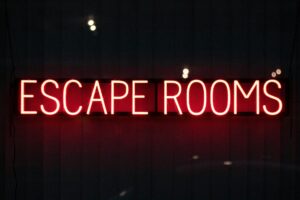Escape rooms have captured the imagination of adventure seekers, offering puzzles, clues, and themes that transport players to different worlds. They aren’t just about solving problems or racing against the clock; they’re immersive experiences crafted to engage and entertain. A key element of this engagement is the thoughtful design of themes. Themes in escape rooms stimulate curiosity and creativity, making each adventure unique and memorable. As you step into a room, you’re not just entering a game—you’re diving into a story.
The magic of an escape room lies in its design. Just like a well-crafted movie set, every detail from lighting to props contributes to the story being told. This allows players to fully immerse themselves in the experience and lose themselves in the role they’re playing. Whether it’s solving mysteries in a detective’s office or finding treasure in a pirate’s cove, the theme sets the scene for an unforgettable adventure.
The Role of Themes in Escape Rooms
Themes are the heart of an escape room. They are what draw players into the story and keep them engaged throughout the game. But why do they matter so much? A well-developed theme connects all elements of the room, creating a seamless experience where everything makes sense. This connection helps players stay focused and encourages a deeper level of involvement.
Consider these popular escape room themes:
1. Historical Adventures: Step back in time to ancient Egypt, medieval castles, or the Wild West. Historical themes offer a chance to learn and explore different eras while solving puzzles that fit the setting.
2. Fantasy Worlds: Enter the realm of dragons and wizards or dive into underwater adventures. Fantasy themes let players experience the impossible and unleash their imaginations.
3. Horror and Mystery: For those who enjoy a good scare, horror themes can provide adrenaline-pumping experiences. Cursed mansions, haunted hotels, or abandoned asylums make excellent backdrops for those seeking thrills.
A great theme does more than just provide a colorful background; it fosters an emotional connection. When players identify with the story and characters, they become invested in the outcome. This engagement is not just about completing the game; it’s about living an adventure where every action brings them closer to the story’s conclusion.
As themes continue to evolve, the creativity in escape rooms grows, offering endless possibilities for fun and exploration. Through captivating settings and intriguing narratives, escape rooms continue to inspire and entertain people of all ages.
Elements of Successful Escape Room Design
Successfully designing an escape room involves more than just picking a theme. It’s about creating an atmosphere where every detail counts, from the setting to the challenges within. The room’s set design should transport players as soon as they walk in. This means carefully choosing props, backdrops, and lighting that align with the theme. Imagine stepping into an abandoned castle—every creaky floorboard and dimly lit corridor should scream medieval mystery.
Puzzles are another key aspect. They need to fit the narrative and challenge players while keeping them engaged. A pirate-themed room, for instance, might include decoding maps or unlocking treasure chests. These puzzles need to make sense in the context of the story to maintain immersion. Storylines and narratives tie everything together, ensuring that players feel like characters on a quest, not just puzzle solvers. The story should unfold as they progress, offering clues and creating suspense that drives them to the next challenge.
Impact of Escape Room Designs on Player Experience
The way a room is designed can make or break the player’s experience. Immersive environments have the power to pull players into the adventure completely. The more believable the setting, the more players suspend reality and buy into the story. This immersion is what makes escape rooms so engaging and addictive.
A cohesive design keeps things smooth and avoids frustrations that can arise from poor execution. It’s important to have a well-thought-out flow that guides players logically from one puzzle to the next, without breaking the narrative. This ensures the game feels fluid and enjoyable rather than disjointed or forced. When everything clicks into place, players are more likely to talk about the experience and recommend it to others.
Tips for Creating Memorable Escape Room Themes
Crafting a theme that sticks in players’ minds involves balancing creativity with usability. Here are some tips to consider:
– Balance difficulty and fun: Ensure puzzles are challenging but not impossible. You want players to think but also feel accomplished when they solve something.
– Use technology and special effects: Integrate tech like sound effects or projections to give the room a high-tech edge without overwhelming the story.
– Make it accessible and inclusive: Consider players of all abilities—rooms should be welcoming and navigable for everyone.
Wrapping Up Your Escape Room Adventure
Escape rooms offer a glimpse into creative worlds where imagination and design come together to create an adventure worth remembering. As you explore these intricately crafted spaces, you’re not just playing a game; you’re diving into a narrative crafted with care and precision. Each room is an opportunity to step into another world, where the only limit is your imagination. Let the themes lead you on an exciting journey filled with challenges, mystery, and most importantly, fun.
Immerse yourself in the captivating themes that ignite your imagination at Premier Escape Adventures. Discover why every escape room is a journey with intricately designed concepts that transport you into another world. Whether you’re seeking excitement or a challenging escape, explore the best escape room in Sarasota and let the adventure begin. Start planning your escape today!



